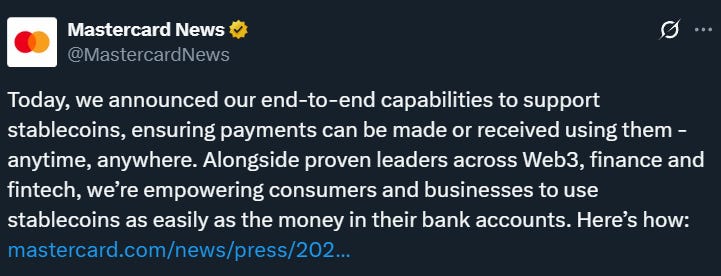Analysis: Mastercard, Visa & Stripe huge push into stablecoin and AI commerce
Mastercarding the Internet Economy
Gm Fintech Architects —
Today we are diving into the following topics:
Summary: We examine how stablecoins and AI-driven commerce are converging into the future of digital payments, with players like Visa, Stripe, and Mastercard leading the charge. Stripe is gradually integrating stablecoins like USDC and USDP into its platform, while both Visa and Mastercard are enabling stablecoin usage across their network through partnerships with wallets, exchanges, and fintechs, and launching “agentic tokens” for AI-powered payments. These initiatives reflect a growing belief that both onchain infrastructure and intelligent agents will transform retail and B2B payments, potentially channeling trillions in future commerce. Though this transformation is still early, the payment layer is likely to be one of the biggest winners, with $10B in revenue per trillion dollars of processed volume at stake.
Topics: Stripe, Mastercard, JPMorgan, Microsoft, IBM, Braintree, Checkout.com, OpenAI, Anthropic, Shopify, Block, Facebook
To support this writing and access our full archive of newsletters, analyses, and guides to building in the Fintech & DeFi industries, see subscription options below.
AI Newsletter
Our sister AI newsletter, Future Blueprint, covers AI news twice a week with an emphasis on up-skilling and new tools. Learn more ➡️ here.
Analysis
Mastercarding the Internet Economy
It’s stablecoin season.
Stripe, which had paid a 1.6% chunk of its marketcap for Bridge, is building out a new stablecoin product.
I wonder if that means launching its own stablecoin, or, integrating stablecoin orchestration more deeply into Stripe’s platform. We don’t have a ton of visibility in what Stripe is going to do, although there are stablecoin capabilities the company has already shown to the world.
An interesting screenshot of an integrated product is shown above. Props to the Stripe team for calling it “Crypto” and not digital assets, stablecoins, or some other euphemism.
The supported currencies are USDC on Ethereum, Solana, and Polygon, and USDP (PayPal) on Ethereum and Solana. There are transaction limits of $10K per transaction and $100K per month in crypto exposure.
The natural questions are about (1) the wallet experience and whether users ever touch things with non-custodial wallets, and (2) whether the underlying account structure is using some large automated smart account management, like Privvy. Having Stripe move in this direction won’t make much difference yet for Stripe’s enterprise value, but it will make a big difference in what financial instruments are being used to power up online commerce.
Here’s our prior coverage on these topics, which can help you to see where payment processing is going directionally. This is an “Instagram by Facebook” kind of moment for Stripe, testing whether they can navigate the shift from Fintech to DeFi — in the broader sense of onchain finance — that is coming for all of financial services.
And here’s another data point.
Visa and Bridge have launched a new card-issuing product that lets fintech developers offer stablecoin-linked Visa cards through an API. When a user pays with a Bridge-enabled Visa card at any merchant that takes Visa, funds are deducted from their stablecoin balance, converted to fiat, and settled with the merchant in local currency — just like a traditional card payment. Cards can also be added to compatible digital wallets for mobile use.
Bridge handles the movement and conversion of stablecoins behind the scenes, helping developers manage programs across multiple countries. Issuance begins in Argentina, Colombia, Ecuador, Mexico, Peru, and Chile. Expansion to Europe, Africa, and Asia is expected soon. Lead Bank acts as the financial institution partner for these card programs. It seems to be one of the few still-standing banking-as-a-service providers, and is notably not middleware (RIP Synapse).
Mastercard is not far behind, announcing an almost identical press release the day before.
The company describes all of its stablecoin initiatives here. To be fair, this work started nearly half a decade ago. When I was at Consensys and we were working with large banks and networks on early tokenization strategy in 2019-2022, Mastercard was a deeply engaged counterparty, thinking about everything from money movement, to stables, to CBDCs.
Here’s what Mastercard just announced:









